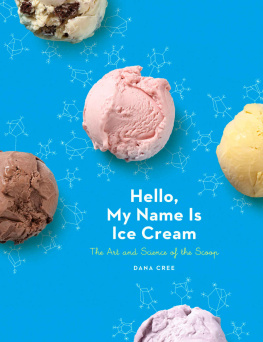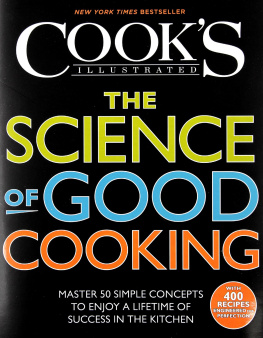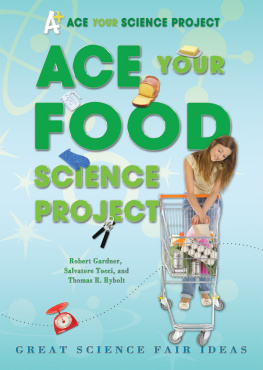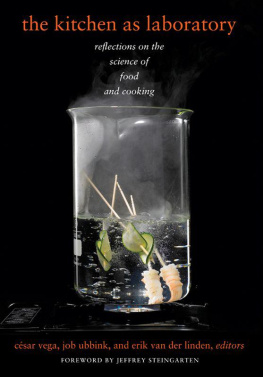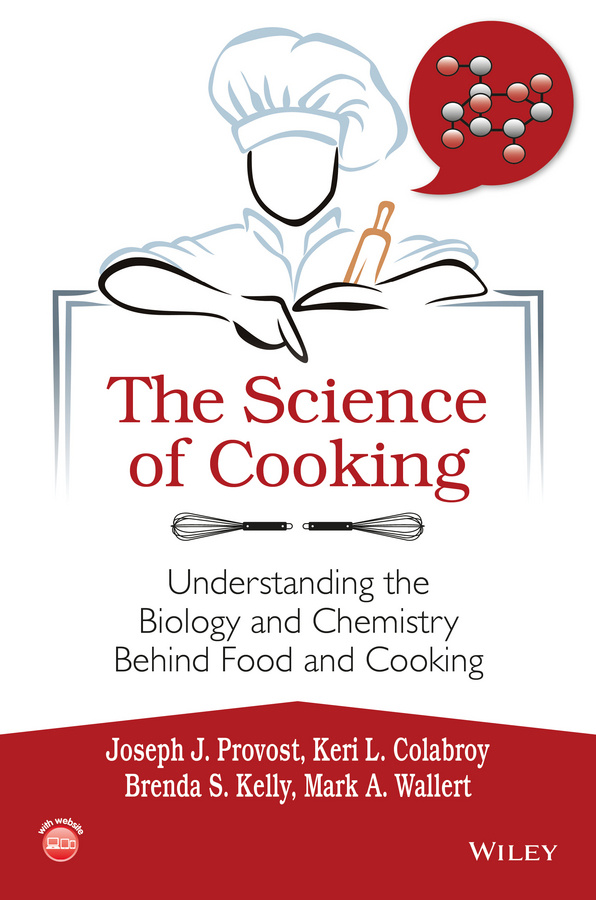
Table of Contents
List of Tables
- Chapter 01
- Chapter 02
- Chapter 03
- Chapter 04
- Chapter 06
- Chapter 07
- Chapter 08
- Chapter 09
- Chapter 10
- Chapter 11
- Chapter 12
- Chapter 13
List of Illustrations
- Chapter 01
- Chapter 02
- Chapter 03
- Chapter 04
- Chapter 05
- Chapter 06
- Chapter 07
- Chapter 08
- Chapter 09
- Chapter 10
- Chapter 11
- Chapter 12
- Chapter 13
Guide
Pages
THE SCIENCE OF COOKING
Understanding the Biology and Chemistry Behind Food and Cooking
JOSEPH J. PROVOST
KERI L. COLABROY
BRENDA S. KELLY
MARK A. WALLERT
Copyright 2016 by John Wiley & Sons, Inc. All rights reserved
Published by John Wiley & Sons, Inc., Hoboken, New Jersey
Published simultaneously in Canada
No part of this publication may be reproduced, stored in a retrieval system, or transmitted in any form or by any means, electronic, mechanical, photocopying, recording, scanning, or otherwise, except as permitted under Section 107 or 108 of the 1976 United States Copyright Act, without either the prior written permission of the Publisher, or authorization through payment of the appropriate per-copy fee to the Copyright Clearance Center, Inc., 222 Rosewood Drive, Danvers, MA 01923, (978) 750-8400, fax (978) 750-4470, or on the web at www.copyright.com. Requests to the Publisher for permission should be addressed to the Permissions Department, John Wiley & Sons, Inc., 111 River Street, Hoboken, NJ 07030, (201) 748-6011, fax (201) 748-6008, or online at http://www.wiley.com/go/permissions.
Limit of Liability/Disclaimer of Warranty: While the publisher and author have used their best efforts in preparing this book, they make no representations or warranties with respect to the accuracy or completeness of the contents of this book and specifically disclaim any implied warranties of merchantability or fitness for a particular purpose. No warranty may be created or extended by sales representatives or written sales materials. The advice and strategies contained herein may not be suitable for your situation. You should consult with a professional where appropriate. Neither the publisher nor author shall be liable for any loss of profit or any other commercial damages, including but not limited to special, incidental, consequential, or other damages.
For general information on our other products and services or for technical support, please contact our Customer Care Department within the United States at (800) 762-2974, outside the United States at (317) 572-3993 or fax (317) 572-4002.
Wiley also publishes its books in a variety of electronic formats. Some content that appears in print may not be available in electronic formats. For more information about Wiley products, visit our web site at www.wiley.com.
Library of Congress Cataloging-in-Publication Data
Names: Provost, Joseph J., author. | Colabroy, Keri L., author. | Kelly, Brenda S., author. | Wallert, Mark A., author.
Title: The science of cooking : understanding the biology and chemistry behind food and cooking / Joseph J. Provost, Brenda S. Kelly, Mark Wallert, Keri L. Colabroy.
Description: Hoboken, New Jersey : John Wiley & Sons, 2016. | Includes bibliographical references and index.
Identifiers: LCCN 2015041520 (print) | LCCN 2015044584 (ebook) | ISBN 9781118674208 (pbk.) | ISBN 9781119210320 (pdf) | ISBN 9781119210337 (epub)
Subjects: LCSH: FoodAnalysis. | Biochemistry. | FoodComposition. | FoodBiotechnology.
Classification: LCC TX545 .P76 2016 (print) | LCC TX545 (ebook) | DDC 664/.07dc23
LC record available at http://lccn.loc.gov/2015041520
PREFACE
Interest in cooking, baking, and food has risen tremendously over the past few years. In fact, the popularity of food and cooking within the 1834-year-old demographic group draws more than 50 million viewers to food- and cooking-based cable shows and websites each month. Many faculty members have tapped into this interest, creating unique and interesting courses about science, food, and/or cooking. This aim of The Science of Cooking: Understanding the Biology and Chemistry Behind Food and Cooking is to teach fundamental concepts from biology and chemistry within the context of food and cooking. Thus, the primary audience for the text is nonscience majors, who are fulfilling a science curricular graduation requirement. However, we anticipate that there may be instructors and students with a more significant interest in science who may utilize the book as a catalyst to fuel further study in the area. We hope that this book helps reduce the barriers to teach courses related to science, food, and cooking and opens up new opportunities for those already teaching about food and cooking.
We also recognize that there are important pedagogical approaches to learning that are well beyond the scope of a textbook. The companion website has over 35 guided inquiry activities covering science basics such as chemical bonding, protein structure, and cell theory and such food-focused topics as meat, vegetables, spices, chocolate, and dairy. These are carefully crafted and classroom-tested activities designed for student teams to work on under the guidance of an instructor. The activities introduce the scientific concepts in a way that complements the text while giving students practice in critical thinking about the relevant foundational principles of chemistry and biology. We have also created a series of food- and cooking-based laboratories. These experiential learning opportunities involve hypothesis design and help teach the scientific process and critical concepts while engaging students in fermentation, cheesemaking, analyzing food components, and other hands-on exercises. The laboratories have been designed to minimize cost and hazardous materials; some are even appropriate to assign as homework to be done in a students home kitchen.
The Science of Cooking: Understanding the Biology and Chemistry Behind Food and Cooking is food centered while including several chapters that introduce fundamental concepts in biology and chemistry that are essential in the kitchen. In the first few chapters of the book, students will learn about molecular structure, chemical bonding, cell theory, signaling, and biological molecule structure. These concepts are drawn upon in later chapters; for example, students will learn the science behind cheesemaking, meat browning, and fermentation processes. The chapters are also full of interesting facts about the history of the food, ailments, or cures associated with the food, all guided by in-depth discussions of the science behind the food.
Of course, there is a rich history of literature on and the science of food and cooking. We have taken some space to acknowledge those who helped build and grow modernist cooking. Special thanks go to Harold McGee and Shirley O. Corriher for their pioneering work, inspiration, and kind words as we developed this work. We hope to add to the scientific culture that they and others have created in the kitchen.
Inquire, Learn, Investigate, and Eat Well!
ABOUT THE AUTHORS
Dr. Joseph J. Provost is a professor of chemistry and biochemistry at the University of San Diego. He has helped create and teach a science of cooking class and taught to small and large classes. Provost has served on educational and professional development committees for the American Society for Biochemistry and Molecular Biology, Council on Undergraduate Research, and the American Chemical Society while teaching biochemistry, biotechnology, and introductory chemistry laboratories. For the past 18 years, he has partnered with Dr. Mark Wallert as they research non-small cell lung cancer focusing on processes involved with tumor cell migration and invasion. When not in the lab or class, Provost can be found making wine and cheese, grilling, and then playing or coaching hockey.
Next page


